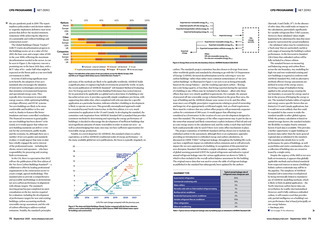




CPD PROGRAMME | NET ZERO the pre-pandemic peak in 2019. The report implores policymakers and decision-makers to urgently implement definitive near-term actions that deliver the needed emissions reductions while achieving the objectives of a sustainable and resilient buildings and construction sector. The Global Buildings Climate Tracker14 (GBCT) tracks decarbonisation progress in the buildings sector, set at a value of 0 for 2015, the base year, and a target value of 100 in the year 2050, reflecting the maximum decarbonisation needed in the sector. As can be seen in Figure 2, the trajectory was not a promising one in the latest 2021 data, with a BCT value of 8.1 under half what might be expected on the linear path to a net zero built environment in 2050. In terms of delivering significant nearterm benefit, the adoption of net zero standards also encourages the adoption of innovative technologies and practices that minimise environmental footprints and operational energy costs. They typically drive investment in renewable energy sources, while optimising building envelope efficiency and HVAC systems. Net zero buildings are likely to be more comfortable and healthier to live and work in, thanks to features like better insulation and more controlled ventilation. The financial investment in good quality net zero buildings has been shown15 to be sound, so it would appear that robust net zero building standards can deliver a winwin for the environment, public health, and the economy. So, although there are a number of net zero guides and standards in place, it would appear that none to date have wholly engaged the active interest of the professional teams including the clients, owners and operators who have responsibility for procuring and creating built environments. In the UK, there is expectation that 2023 will see the publication of the first edition of the Net Zero Carbon Buildings Standard16 a collaborative effort by leading professional organisations in the construction sector to create a single, agreed methodology. This standard aims to provide a comprehensive and accessible methodology to demonstrate net zero carbon performance in alignment with climate targets. The standards steering group has just completed an open consultation on the key metrics required for evaluation, including the development of performance targets for new and existing buildings; carbon accounting methods; renewable energy assessment; and the role of carbon offsetting to address residual emissions. Notably, the standards principles 72 September 2023 www.cibsejournal.com Nations World Europe USA UK Cities World Europe USA UK Companies World Europe USA UK Achieved external validated Achieved self declared In Law In policy document/corporate strategy Pledged Proposed No net zero target Figure 1: An indication of the status of net zero policies across the World, Europe, USA and UK as at 1 August 2023 (Data source: Oxford Net Zero Tracker13) and many of the methods are likely to be applicable worldwide. ASHRAE holds a significant place in engineering built environments around the world. As such, the recent publication of ASHRAE Standard17 228 Standard Method of Evaluating Zero Net Energy and Zero Net Carbon Building Performance has excited interest for its potential to be applicable as a global tool to determine if a building or site has achieved net zero. It provides a generally simple compliance pro forma, with supporting data tables that, when completed with relevant data for a specific application at a particular location, indicates whether a building or development is likely to operate at net zero. This generally uncomplicated approach could be extended beyond North America but, in this first edition, it is very much constrained to application in the US and Canada. In developing the standard, the committee took inspiration from ASHRAE Standard 105 (a standard that provides consistent methods for determining and reporting the energy performance of buildings); it decided to discourage the development of inefficient buildings that need significant amounts of onsite renewables in order to attain net zero as well as acknowledging that many sites may not have sufficient opportunities for renewable energy production. Notably, in a novel departure for ASHRAE, this standard relates to carbon equivalency as well as ASHRAEs traditional realm of energy performance in the many available global net zero publications, the focus is typically singularly on 20 18 Linear reference path towards 2050 goal 16 14 11.3 pandemic outlier 12 10 8 6 6.6 4.2 (+2.2%) 2 0 2015 Buildings Climate Tracker 4.8 (+165%) 4.1 4 2016 2017 8.1 (+68%) 1.8 (-56%) 2018 2019 2020 2021 (%) Per cent change compared with the previous year Figure 2: The observed Global Buildings Climate Tracker compared with the linear reference path to a zero-carbon building stock target in 2050 (Source: UNEP 2022 Global status report for buildings and construction) 9.0